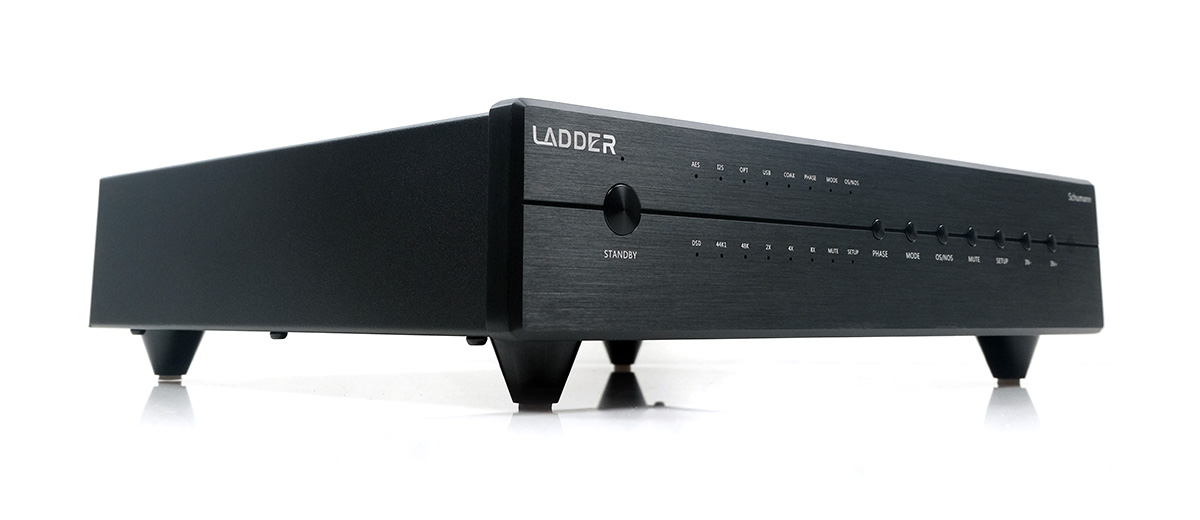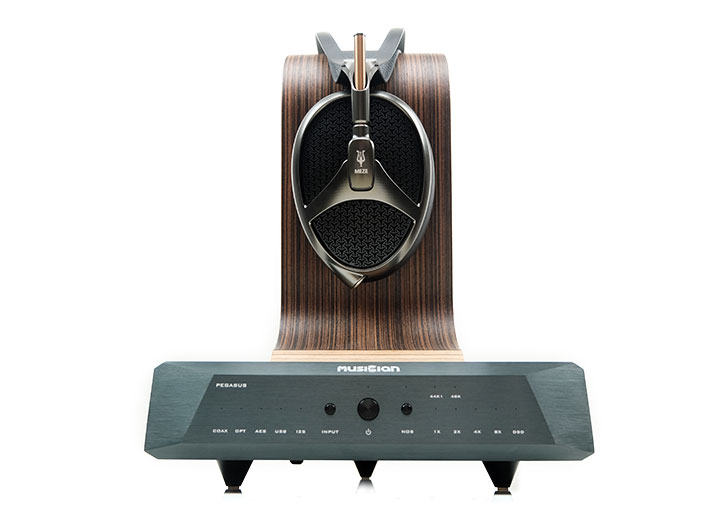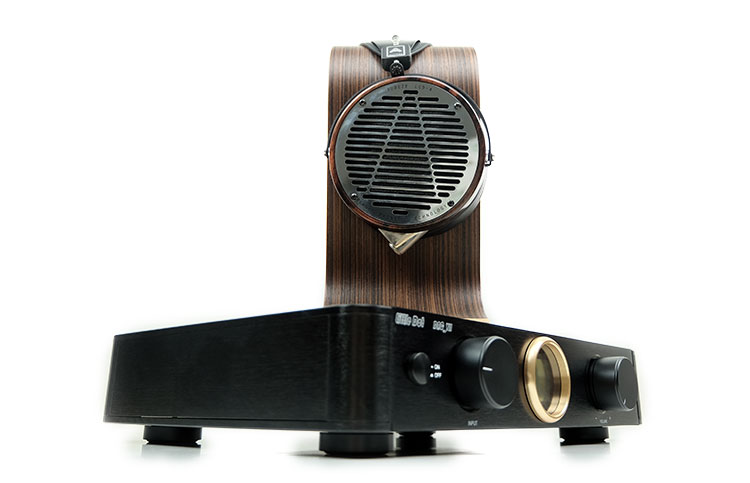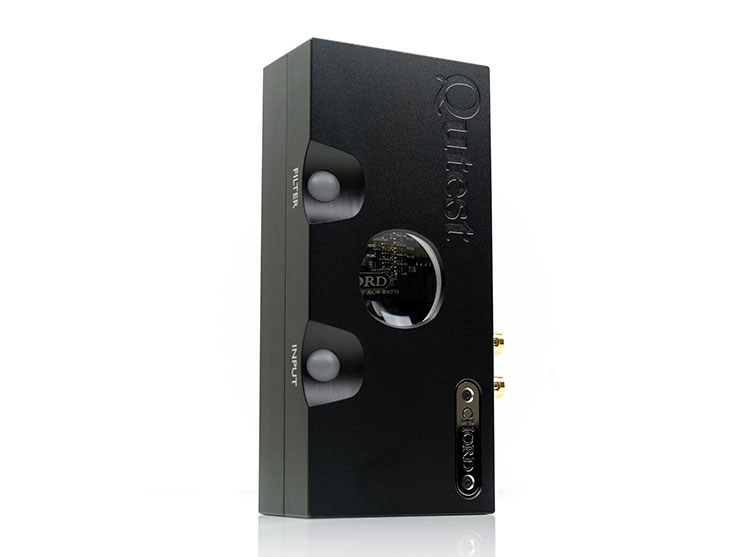Select Comparisons
The following comparisons with the Ladder Schumann DAC were completed using a Ferrum OOR and HYPSOS amplifier and PSU combo combined with Dan Clark Audio’s EXPANSE and the ZMF Headphones Atrium open-back headphones.
Our source was a Cayin N7 via an I²S connection and a direct USB connection with a Windows 10 PC using the supplied ASIO drivers combined with Foobar2000.
Musician Audio Pegasus
$1099
The Musician Audio Pegasus was launched back in 2021 and represented the company’s debut HiFi product with subsequent amplifier and preamp releases shortly after. It also achieved our Top Gear 2021 Best DAC Award. You can read our full review of the Pegasus here.
Technical
Like the Ladder Schumann DAC, the Pegasus is also a discrete-engineered balanced desktop R-2R decoder with similar specs and features.
However, there may be a potential difference in the upper-tier decoding capability since we have an official spec of up to DSD1024 and 32BIT/1536kHz for the Pegasus and were only able to successfully test up to DSD512 for the Schumann DAC.
Both DAC use discreet-engineered topologies with a multi-bit resistor-based ladder network array for PCM decoding and a separate 6BIT array for DSD backed by an Altera Cyclone IV FPGA and dual crystal oscillation for noise shaping and jitter control.
I am not 100% sure what the exact USB stage is inside the Schumann DAC so it could well be an off-the-shelf XMOS or an ARM Cortex-M4-based chipset. Coming with its own ASIO driver and with the ability to upgrade the onboard driver directly from Shenzhen Audio’s website, I suspect it does have its own custom algorithm for digital decoding.
You are not limited to USB decoding though for either DAC. Both do come with similar input options including my preferred I²S which has the same upper-tier limit as USB, and more traditional coaxial and optical formats with up to 24BIT/192k PCM and DSD64-DoP decoding.
Design
The Schumann DAC is a bigger unit compared to the slimmer and narrower Pegasus. It is also a more traditional boxy shape whereas the Pegasus has that streamlined or angular front panel and for me a better set of panels than the Schumann DAC behind the thick front plates.
What I am not keen on is the Pegasus rubber feet in a trip configuration. I much prefer the Schumann DAC’s symmetrical 4 feet or 1 in each corner compared to the 3 feet layout on the Musician Audio unit. Both are steady if untouched but apply any weight at all to the back of the Pegasus and it will tip to one side.
Neither of these DACs has an LED display or remote controls. Both are switch or mechanical-based for operation with a lot of overlapping features including NOS/OS and source input selection with sides for status and sample rate displays.
The Schumann DAC control suite does have a few additional options such as Phase and deeper options in its setup control. Arguably the Schumann DAC feature suite is closer to the Musician Audio Aquarius DAC which is the next level up from the Pegasus but at over twice the price.
I/O on the rear of each DAC is an exact match so there is no competitive advantage for either here. If you want something to cling onto then is that jutting overhand of the Pegasus chassis which can make life a bit more difficult with connecting or disconnecting IC cables. You get a cleaner finish on the Schumann DAC with no overhang.
Performance
You are getting a bit of an upgrade in performance here going from the Pegasus to the Schumann DAC.
The Ladder DAC sounds punchier and more vibrant. It offers superior instrumental separation, a blacker background, and more headroom from the OOR/EXPANSE combo.
The treble is not prevalent on either but you can pick up a little more influence in higher pitching instrumental timbre on the Schumann DAC compared to the Pegasus which is softer sounding.
The variable here to create at least some of that difference might be more in the technical domain since the Pegasus impedance output at 1250Ω for its balanced output is considered fairly high. I noted in my 2021 review of that DAC that it can mean a slight diminution in performance when doing an AB on the DAC at matched volumes.
True enough, I did find myself pumping up the volume on the OOR/Pegasus combo but even so, the dynamic range and staging depth of this pairing with the EXPANSE never quite matched the Schumann DAC alternative.
Most notably in the clarity and space around vocal performance combined with the thrust and rumble of the low-end where the Pegasus came across as more neutral in quantity though still slightly on the warmer side.
The Schumann DAC/OOR produced a meatier tone throughout when paired with the EXPANSE sounding tighter with an improved level of definition from each note. You could argue it is not quite as warm as the Pegasus but that may also benefit the perceived level of resolution also.
Little Dot DAC VII
$1199
The Little Dot DAC VII was originally launched in 2019 with our subsequent review being published in mid-2021. As far as I am aware this is still their flagship DAC with a street price at a slightly lower $1089.99 in 2023. You can read our full review of the DAC VII here.
Technical
The DAC VII is a single 8-channel ES9038PRO delta-sigma chipset, unlike the R-2R ladder network inside the Schumann DAC.
Combined with an Amanero Combo384 Module (USB), the DAC VII is capable of decoding up to 32BIT/384kHz PCM and DSD128. Beyond USB, you can get up to 24BIT/192kHz and DSD64 over DoP via SPDIF. All in WASAPI mode which is well below what the Schumann DAC is capable of.
However, using the Amanero-associated ASIO driver (PC), the DAC VII will jump right up to DSD512 and PCM 32BIT/768kHz via USB which is almost as good as it gets for both USB and I²S.
Both have I²S but the implementation is very different. The Schumann DAC has a more widely used HDMI-type socket implementation which opens it up to portable sources with similar outputs such as the Cayin N8ii or N7.
The DAC VII uses I²S over an ethernet RJ45 connection which can link the DAC VII to a LAN network streaming solution or to an I²S pin-compatible source such as a streamer via a conversion cable, (HDMI to RJ45).
Both DAC are balanced-designed out of the box with the DOT VII offering fixed line-out and pre-amping capability with a variable voltage volume control. The Schumann DAC is a fixed voltage SE and balanced line-out DAC only set at what we presume is 2Vrms and 4Vrms, or matching the DAC VII.
Design
The DAC VII is one heck of a hefty DAC and very solidly built. The Schumann DAC is what you might call a medium-sized component system but nowhere near as heavy as the 5kg DAC VII.
Both have fairly large transformers inside but aside from the more sizeable and curvier dimensions, the DAC VII chassis is a relatively thick aluminum paneling with a very discreet nut and bolt locking system on the underside. It’s a bit like the Schumann DAC’s control panel but covers the entire housing and not just the front.
What I do like about the DAC VII is that it has both a remote control and a built-in LED display system controlled by a simple input multifunction rotary dial and a volume dial to the right for the pre-amp.
What I am not hugely keen on is the restrictive or time-limited DAC VII display light as well as the very cheap remote control it does come with. In some ways, the Schumann DAC’s simpler light display and mechanical buttons system can feel more immediate in terms of getting a quick read on what is happening with your DAC.
I/O on the back of each DAC is quite similar though with the only key difference being the absence of an AES XLR socket on the DAC VII which is replaced with the RJ45 streaming port.
Performance
Both of these DACs hit hard on the low end using both the Atrium and the EXPANSE. However, the Schumann DAC has a better sub-bass presence overall, whereas the DAC VII delivers more of a snappy punch and an uplift in the upper harmonic order of its notes.
What that means is it shines a little brighter in its timbre whereas the Schumann DAC tonal balance is a bit thicker sounding. The level of note separation and imaging is very good on both DACs combined with the OOR but the emphasis is again on the DAC VII treble presence coloring the timbre.
The DAC VII has more headroom and treble extension and you can pick that up in the busier percussion or higher-register notes, particularly with the ORR/EXPANSE pairing. The Schumann DAC tones it down from the upper mids upwards which draws your ear more to the bass and mids whereas the DAC VII is more upper mids and treble dominant.
Now, I would not call the DAC VII a brighter-sounding DAC but it does have a brighter overtone compared to the smoother Schumann DAC’s upper octave performance. You can pick this up in some vocal performances that have a shaper attack or shorter decay with a little more sibilance coming through.
The Schumann DAC is more weighted to its lower harmonic order so it sounds clear with excellent surrounding space but each note from the two headphones came across as heavier and denser in texture.
Just a final note, there is no difference in the dynamic range performance of either DAC using their balanced analog outputs but just remember that if you need the maximum variable voltage volume rating, (100), on the DAC VII to match the fixed voltage output of the Schumann DAC.
Chord Electronics Qutest
£1195.00
The Chord Electronics Qutest is a long-running product release and possibly one of their most popular DACs, at least for headphone enthusiasts. It also won our Top Gear 2018 Best DAC award. You can read our full review of the Qutest here.
Technical
The key selling feature of the Qutest is that its DAC is neither an off-the-shelf delta sigma like the DAC VII nor is it a ladder network R-2R DAC such as the one inside the Schumann DAC.
This is an entirely in-house Xilinx Artix 7 FPGA-driven design with a focus on their proprietary WTA digital filter and the number of taps it can produce which is many times more than a standard delta-sigma chipset setup.
In a way both traditional R-2R inside the Schumann DAC and Chord approach have the same guiding principle and that is engineering control over a wide range of parameters to ensure they get exactly what they are looking for in the performance.
Decoding on both is the same at PCM up to 32BIT/768kHz and DSD512 via USB with the Qutest able to offer 32BIT/768kHz via dual BNC and the Schumann DAC the same level via its alternative I²S capability. Neither DACs offers any MQA unfolding capability.
Using one BNC coaxial connection the Qutest will drop it down to 32BIT/384kHz decoding and both DAC will also give you optical output at a maximum of 24BIT/192kHz. The Qutest is also modular so slipping in a Hugo 2 M Scaler will allow upsampling to 768kHz via dual BNC where applicable though at a heavy additional budgetary cost.
Note, that both DACs have no pre-amp capability with a fixed voltage lineout only. However, The Schumann DAC will give you both SE and balanced at 2Vrms and 4Vrms whereas the single-ended only Qutest has 3 levels of line out voltage you can cycle through at 1Vrms, 2Vrms, and 3Vrms.
Design
Goodness, how small is the Qutest compared to the Schumann DAC? It is a fraction of its size at 4.5cm (H) 16cm (W) 8.8cm (D) compared to 29.5cm x 25.4cm x 5.6cm.
It really does live up to its “quest” moniker though the aluminum billet design is super dense and sturdy and probably more durable than the Schumann DAC chassis. Power is a simple affair for the Qutest also with a DC-regulated 5V power supply plug. You can even run it off a 5V capable power bank if you want a really clean power supply.
And it is packed to the gills with tons of features and a remote control that puts larger DACs to shame. Granted, this is only a single-ended design but you can send up to 3Vrms out of those dual RAC if needed.
The benefit of course for the Schumann DAC is being able to stack and hook up to multiple amplifiers. However, I recommend against this if it is anything like the Pegasus setup which sends signals concurrently to both its SE and XLR outputs. That can diminish your output capability and dynamic range performance.
The major critique of the Qutest is the orb control system. The Schumann DAC might be mechanical and lack a remote but it is much easier to understand, (once you read whatever instructions you can find), compared to the Qutest orb system.
Performance
The Qutest brings a very different flavor compared to the Schumann DAC when paired with the OOR and our EXPANSE and Atrium test headphones.
It’s airier for a start, with a stronger treble presence but still quite a smooth and polished tone. The Qutest expands and stretches the Atrium stage out wider and taller with perhaps a lighter sound but one that is more intricate in imaging.
You get a bit more resolution and articulation from the Qutest, and I suspect it has a slight edge also in its dynamic range given the pace of notes coming in and out sounding a lot faster and more precise.
The Schumann DAC is the more powerful sounding DAC with an organic natural sounding timbre but also a bit darker on the highs. It is also qualitatively slower-paced but note weight was denser and weightier in its delivery.
There is more body in general from the Schumann DAC, particularly in the performance from the Atrium paired with the OOR and Schumann DAC with a solid vocal presence.
Vocal and instrumental timbre is richer and a little more liquid with the Atrium/OOR/Schumann DAC combo. Though I felt the Qutest colored the OOR performance quite sweetly and with more delicacy it can at times sound a little brighter and less forgiving with percussion splashiness or vocal sibilance creeping in.
Our Performance
The Ladder Schumann DAC delivers a true and excellent R-2R performance, or at least one that R-2R fans will enjoy if they are looking for a bump up from current R-2R entry-level offerings.
It is surprisingly weighty on the lows, with a natural fulsome timbre throughout and one that pairs equally well with both SET and solid-state amplifiers. OS can sound a little drier compared to NOS but it has its moments also with brighter recordings or headphones.
The main critique of the Schumann DAC is the lack of insight into what is happening in terms of functionality and specifications. It really needs a manual and one that is deeper than the current basic one doing the rounds online.
So, my apologies if some things like presumed Vrms output or decoding limits are found to be not accurate as it’s a best guess in the absence of firm technical data.
Otherwise, I found the pairings to be tonally very pleasing and definitely a step up on the likes of the Musician Audio Pegasus performance-wise.
Ladder Schumann DAC Specifications
- Decoding: R-2R Ladder Network, FPGA, dual crystal oscillation
- USB & I²S: DSD64 – DSD256/512 & up to 32BIT/384kHz
- SPDIF (Optical & Coaxial) – up to 24BIT/192kHz
- Digital I/O – USB, I²S, coaxial, optical, and AES/EBU
- Analog I/O: 1 x 3-pin XLR balanced, 1 x dual RCA single-ended
- Power: Dahuan Niu O-Ring transformer
- Dimensions: 295mm x 254mm x 56mm





